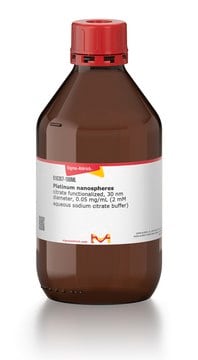773875
Platinum, nanoparticle dispersion
3 nm particle size, 1,000 ppm in H2O, 99.99% trace metals basis
Synonym(s):
Platinum colloid, Pt NP, Pt dispersion
About This Item
Recommended Products
Quality Level
assay
99.99% trace metals basis
form
dispersion
nanoparticle
reaction suitability
reagent type: catalyst
core: platinum
concentration
1,000 ppm in H2O
particle size
3 nm
density
0.997 g/mL at 25 °C
SMILES string
[Pt]
InChI
1S/Pt
InChI key
BASFCYQUMIYNBI-UHFFFAOYSA-N
wgk_germany
nwg
Choose from one of the most recent versions:
Already Own This Product?
Find documentation for the products that you have recently purchased in the Document Library.
Customers Also Viewed
Articles
TiO2 exhibits wide band gap semiconductor and memristor properties electronically, with high opacity and UV absorbance optically.
Catalytic water splitting produces hydrogen crucial for renewable energy, petroleum refining, and chemical industry applications like methanol production.
Controlled synthesis of metal clusters regulates ligands and atoms, advancing metal nanomaterial synthesis.
Nanomaterials are considered a route to the innovations required for large-scale implementation of renewable energy technologies in society to make our life sustainable.
Our team of scientists has experience in all areas of research including Life Science, Material Science, Chemical Synthesis, Chromatography, Analytical and many others.
Contact Technical Service





